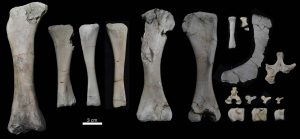Assistant Professor Michael D'Emic, Ph.D., and his team's research on baby sauropod bones challenges previously held theories about the early life of these dinosaurs.
 A newly discovered fossil of a young sauropod dinosaur suggests that newly hatched dinosaurs grew quickly and were largely precocial, which implies they had little to no parental care, a team of researchers has determined.
A newly discovered fossil of a young sauropod dinosaur suggests that newly hatched dinosaurs grew quickly and were largely precocial, which implies they had little to no parental care, a team of researchers has determined.
This tiny dinosaur, found in 68-million-year-old deposits in Madagascar by an international team of researchers, was not a member of a small species but is instead a very young individual of a huge, long-necked dinosaur. It is one of the most complete young juvenile sauropods ever found.
Michael D’Emic, Ph.D., an assistant professor in the Department of Biology at Adelphi University in Garden City, N.Y., was part of the team that studied this fossil, and they’ve written a new paper published in the journal Science that details the discovery.
 “This hatchling dinosaur is remarkable because it is one of the most complete young juvenile sauropod individuals ever found. The new and exciting data that we gathered from [the fossil] centered on its bone microstructure, which we looked at by making microscope slides and taking high-resolution computed tomography (aka CT) scans,” Dr. D’Emic said. “From it we can tell a lot: The individual was only several weeks old when it died, and in its short lifetime it grew to be 10 times its weight. The individual had thin calcified cartilage and its limb bones didn’t change proportions over its lifetime, both of which suggest a growth strategy termed precocial, which in turn implies little to no parental care.”
“This hatchling dinosaur is remarkable because it is one of the most complete young juvenile sauropod individuals ever found. The new and exciting data that we gathered from [the fossil] centered on its bone microstructure, which we looked at by making microscope slides and taking high-resolution computed tomography (aka CT) scans,” Dr. D’Emic said. “From it we can tell a lot: The individual was only several weeks old when it died, and in its short lifetime it grew to be 10 times its weight. The individual had thin calcified cartilage and its limb bones didn’t change proportions over its lifetime, both of which suggest a growth strategy termed precocial, which in turn implies little to no parental care.”
That discovery has the potential to change the way scientists understand how dinosaurs matured and how they raised their young.
“This discovery is significant, since many dinosaurs are believed to have had some degree of paternal care based on their bone microstructure or the discovery of individuals sitting on fossilized nests,” said Dr. D’Emic. “This discovery suggests that some dinosaurs had a precocial growth strategy, just as some birds do today.”
The next step will be to study the bone microstructure of other juvenile sauropod dinosaurs, and luckily, more have been discovered in recent years.
“I was most surprised that we found the presence of a hatching line, which is a ring inside each bone that indicates the size of the individual when it hatched,” Dr. D’Emic said. “It was astounding to see this record of an individual’s hatching 68 million years after it occurred.”
The paper, “Precocity in a tiny titanosaur from the Cretaceous of Madagascar,” appears in the journal Science and was coauthored by Kristina Curry Rogers, Macalester College; Megan Whitney, The University of Washington; and Brian Bagley, the University of Minnesota.
Hear Dr. D’Emic discuss the discovery on NPR’s All Things Considered.
For further information, please contact:
Todd Wilson
Strategic Communications Director
p – 516.237.8634
e – twilson@adelphi.edu